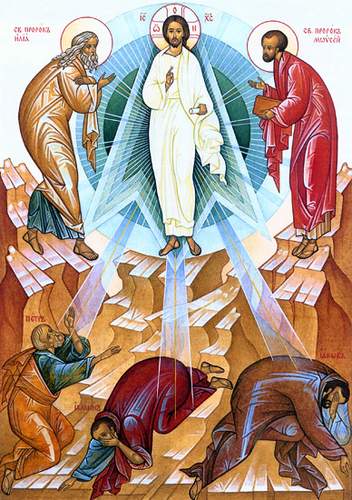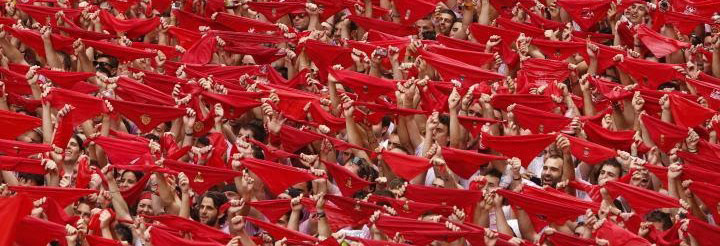
The Transfiguration of Our Lord


According to tradition, Saint Fermin was born in Roman Pompeii in the 3rd century. Converted to Christianity after the preaching of the presbyter Saint Honoratus and the bishop Saint Saturninus, he was baptised together with his family by this prelate from Toulouse. The first bishop of Pamplona, consecrated as such by Saint Honoratus, after a fruitful pastoral activity in his homeland, he went to Gaul as a missionary, travelling through Aquitaine, Auvergne and Anjou. Later the first bishop of Amiens (northern France), he entered the capital of the former Picardy on the tenth of October. He was martyred there on 25 September. report His body was miraculously recovered on 13 January 615 and taken to what was his seat, the cathedral of Amiens, during the episcopate of Saint Salvius.
The City Council asks the Saint for the liberation of Pamplona
from the plague epidemic. The Court declares St. Francis Xavier to be the only
Javier as the only one patron saint, the people oppose this. A fragment
of the martyr's head arrives in Pamplona in 1186...
San Fermín was the main patron saint of the Kingdom of Navarre and of the Diocese of Pamplona from a vague period. He had a chapel in the primitive Gothic church of S. Lorenzo as early as the 14th century. It is recorded that in 1534 the Regiment (City Council) commissioned a silver lamp, with a vow to keep it lit perpetually with oil, as they attributed the liberation of Pamplona from a plague epidemic to the intercession of the Patron Saint. And he also had an altar in the Cathedral in the Middle Ages average (the current one, by Francisco Gurrea, was sculpted in 1710). In 1624, the privative Cortes declared Saint Francis Xavier to be the only one patron saint , a circumstance that led to ecclesiastical dissensions and lawsuits in which the City tenaciously opposed the variation. The solution was conciliatory: in 1657 Pope Alexander VII ordered that both saints should be venerated equally as co-patron saints of Navarre. It should be remembered that in 1725 the Pope granted the prayer of the Patron Saint of Navarre with a double rite for the whole of Spain. And that in 1746 Benedict XIV elevated to a double rite for the City, Diocese and Kingdom of Navarre the official document and mass of the commemoration of the Martyrdom of San Fermín, on 25th September.
Over the course of time, the cult of San Fermín took shape as relics arrived from his tomb. The first known relic, a fragment of the martyr's head, was obtained in 1186 by the bishop of Pamplona, Pedro de París, from the prelate of Amiens, Teobaldo de Heilly. That same year, Don Pedro, also known as "de Artajona" because of his origin, established the liturgical celebration of the saint, giving it the status of the first class, comparable in solemnity to that used for the feast of the Holy Apostles. The Pamplona cathedral conserves this relic in a bust adorned with silver, dated 1527 and transformed in the 18th century.
The Sanfermines are held on 7 July from the end of the 16th century onwards.
the end of the 16th century. The Riau-riau was born at the beginning of the
of the 20th century from the chants and dances that accompanied the
procession with the relics of the saint.
Until the end of the 16th century, the people of Pamplona honoured San Fermín on the uncertain days of autumn, on 10 October to be more precise. It was the liturgical commemoration of entrance of the saintly bishop in his see of Amiens. The choice of this event, which took place in Gaul, to venerate the illustrious Navarrese patron saint is surprising, and can be explained by the human component of Frankish origin, who populated the Pamplona Burgo de San Cernin at the end of the 11th century, to the exclusion of people of other origins. In 1590, the town councillors of Pamplona requested the bishop, D. Bernardo de Rojas, to move the celebration to July, when the weather was mild and coincided with the period of the free fair established by Charles II in 1381. Since 1591 the solemnity has been commemorated on 7 July. Since ancient times, this festivity has included a Vespers service, which was held in the now disappeared Gothic chapel of San Lorenzo, on the afternoon before the main day (9th October and, later, 6th July). The Regiment would attend with all solemnity, accompanied by the people and leading citizens in a procession that, from 1915 onwards, would give way to the Riau-riau. For two centuries, the 6th of July was a day of "penitential vigil", in fulfilment of the vow that the City made in the Chapel of its board of trustees on 17th October 1599, on the occasion of the virulent cholera epidemic that was attacking Pamplona. Until the commutation of this vow at the end of the 18th century, the residents were reminded of their obligation to abstain from meat by means of a proclamation.
The Procession of the 7th of July belongs to the so-called "seasonal" class . Starting from an important temple, in this case the Cathedral, the procession goes to the Chapel to take the image, which is also the reliquary of the martyr, to make a "processional station" with mass, after which it returns to the Cathedral. Properly speaking, the procession begins and ends at the Cathedral, although some interpret the return as a mere courtesy accompaniment or label on the part of the City Council to the Chapter. The secular pathway allows the three old centres of classical Pamplona to be visited: the Burgo, the Población and, minimally, the Navarrería. Occasional processions with the effigy of San Fermín were once frequent, motivated by rogations, requesting rain(ad petendam pluviam) or the cessation of storms(ad repelendas tempestates).
In 1689 the feast was not celebrated either,
not because of the pandemic, but because of mourning.
What happened to the money saved?
- Origin of the Octave.
The origin of the Octave is tinged with mourning. When the celebration of San Fermín was imminent in July 1689, Pamplona, like the entire Hispanic Monarchy, was in official mourning due to the death the previous February of María Luisa de Orleans, wife of Charles II the Bewitched. It seemed to the City Council that the necessary savings on bulls, fires and dances could well be applied to increasing the demonstrations of worship, then limited to the mass and procession. So, on the 5th of July, he decided to incorporate an Octave into the liturgy, with daily sung mass and "sermon on the first and last day, with the City attending both, as it does on the feast of the Conception". At the same time, it makes it more expensive for later corporations to maintain the novelty. Currently the octave is limited to the mass on the 14th, with attendance of the Corporation.